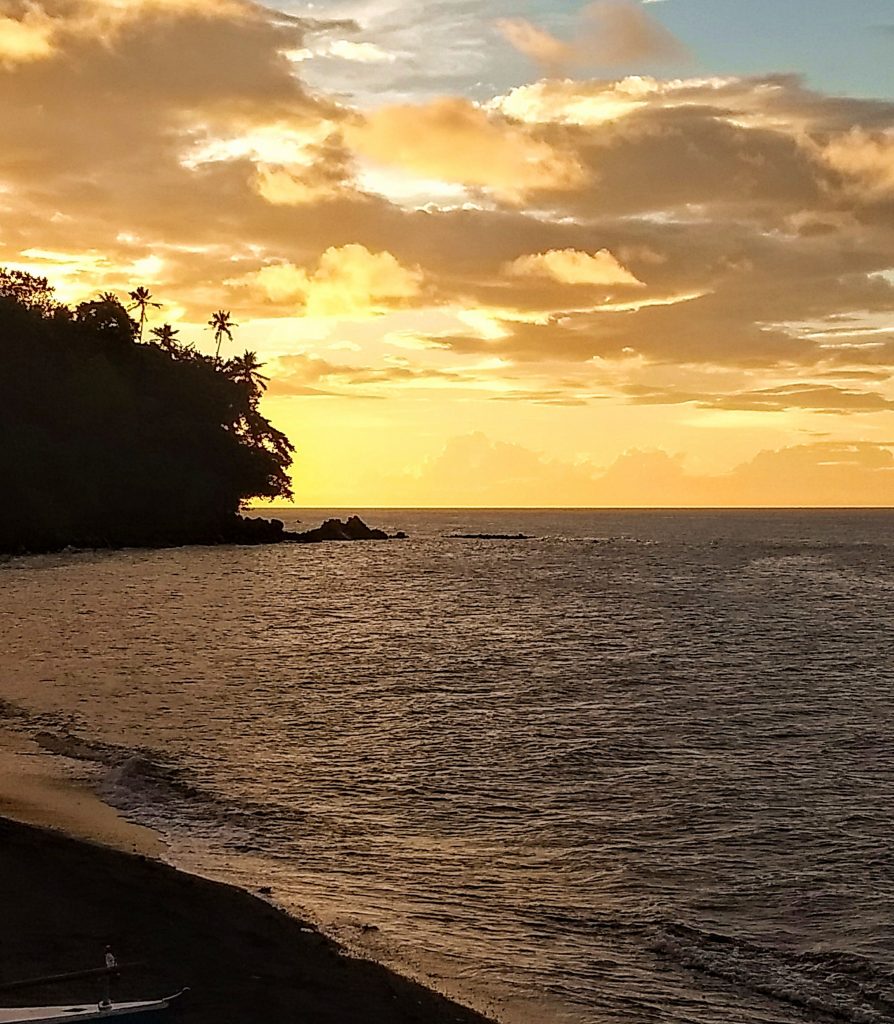May 2018
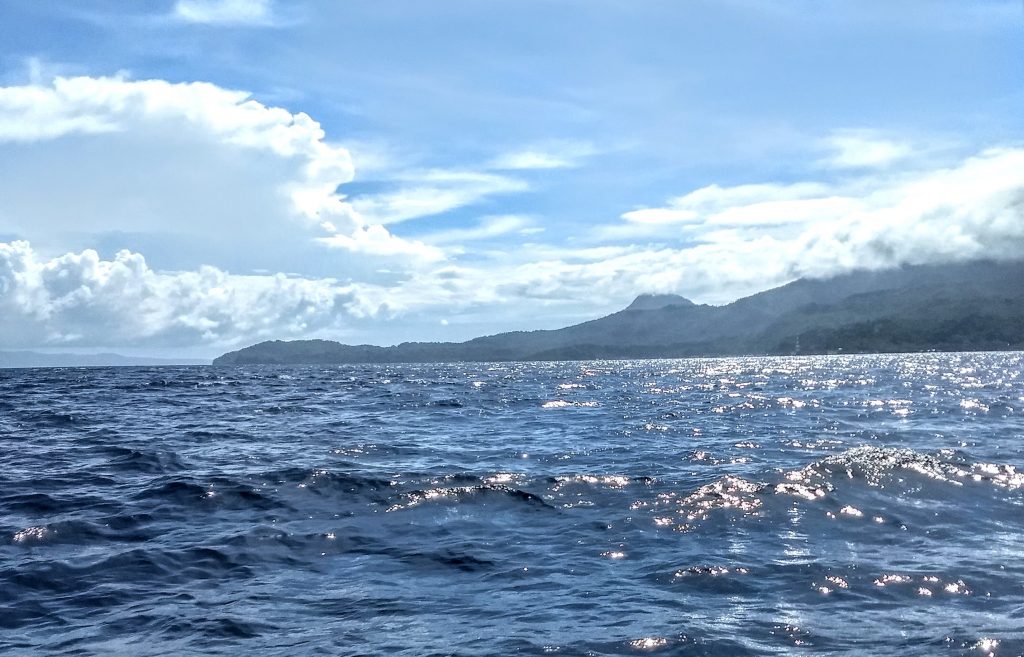
The islands of the Philippines offer such diversity of topography and landscape that travel within the country can keep your bucket list filled up for quite a while. The large islands such as Luzon and Mindanao are like small countries in themselves, with all the diversity of landscape and culture one could wish for. Even the smaller main islands such as Panay and Negros have that same variety on offer, although they accomplish it with a smaller footprint on the map.
The small islands, however, are a different matter. There’s not much real estate to work with, so a small island is usually known for one thing, and in most cases that means: beach. Hardly surprising, given that we’re talking about an island nation in the tropics. Camiguin is a special case among the smaller islands in that it’s not a flat coral island offering a pristine white sand beach as its main attraction. It’s a piece of “Castaway” movie-style South Seas stuck smack dab in the Philippines and as such offers an environment unique among the small islands of the country.
The credit for Camiguin’s similarity to the South Seas classics like Fiji (where “Castaway” was filmed, on Monuriki in the Mamanuca group) goes to its volcanoes. The island is made up of seven volcanoes, all but one extinct at this point, although there are hot springs and soda pools and such things that show there’s still magma down there lest that fact slip our minds. Fortunately, there’s nothing on the order of magnitude of the Luzon volcanoes, for example the Mayon volcano in Albay which recently started spouting again, or, God forbid, Pinatubo that blew its stack in 1991 to widespread and devastating effect. Nevertheless, a volcano is a volcano, and living with a volcano involves an element of risk. The last eruption of Mt. Hibok-Hibok, the one volcano still considered active, occurred in 1951 and caused 3,000 fatalities, which for an island population of less than 100,000 is enough to raise eyebrows and perhaps the blood pressure, as well, if you’re the nervous type. Despite the relatively recent history of activity from the one loaded gun left in the holster, you don’t find people sitting about on pins and needles wondering if they’ll be buried in ash or incinerated by a pyroclastic flow before that favorite soap opera comes on at 8PM. Another important point of similarity is the fact that most of the land area of the island is mountainous, with only a narrow coastal strip circling the volcanoes that form the majority of the island’s landmass.
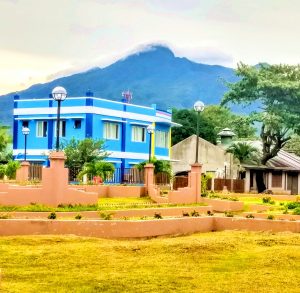
I flew to the island for a stay of 5 days last November, which proved to be among the most interesting island experiences I’ve had so far in the Philippines. As soon as you step off the plane the volcanoes command your attention. They loom up into your field of vision no matter where you are on the island because they are the island. I found that looming presence enchanting, coming from the flatlands of Iloilo on Panay Island where the mountains of Antique Province are only visible as a band of blue bumps at fair distance. On Camiguin the mountains — which is to say the volcanoes — are always front and center unless you turn your back on them altogether to stare out over the sea. During my time on the island I became attached to that towering presence like the inhabitants of a South Seas island must do. For things to be flat would just seem all wrong.
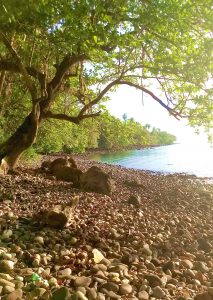
Since the island is volcanic in origin, one looks in vain for those famous beaches like the ones in Boracay or Palawan — the long white ones, set against the azure of sea and sky. White sand doesn’t come from basalt, which is what the molten crust throws up in its volcanic fits. Consequently, Camiguin is no place for you if what you’re after is white sand beaches. The few beaches I explored on Camiguin were all rocky, one of them strewn with baseball-sized rounded stones over which it was almost impossible to pick your way without falling flat on your face. Even where there is sand on the shore, it’s black, not white, because it comes from basalt, not coral. There’s a sand bar off the northern coast, called White Island, which does indeed have a white sand beach, but that’s all it is — no trees, no buildings, just white sand and the sea and the sun. Not my cup of tea, since I’m not a beach bum and I don’t enjoy feeling like a hotdog on a grill. There’s another option for white sand beaches, as well, which I did visit: Mantigue Island, located off the eastern coast of Camiguin and reachable by a pumpboat ride of about 20 minutes. Guests can stay for about four hours to use the beach area and the beach huts. There are few facilities and no running water, so come prepared if you make the trip over. It’s the classic white sand island, as tropically paradisical as you please, so if the black sands of Camiguin get you down, there is respite available there.
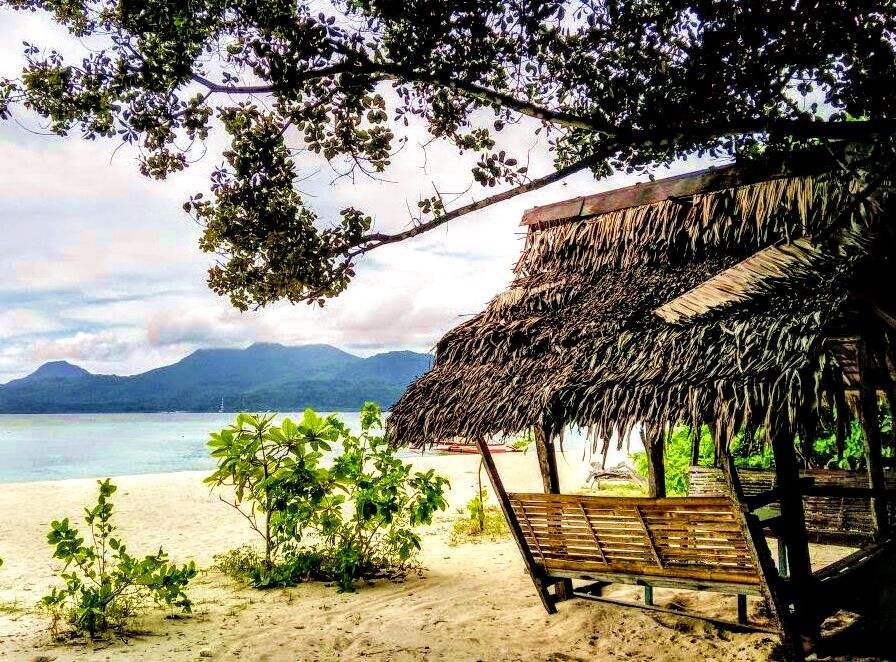

This map appears on the wall of a restaurant in Mambajao, done apparently by some clever and enterprising native of the island. As you can see, there’s a very narrow coastal plain and all the rest is mountains, with only one main road traversing the island. It’s difficult to tell from maps, even topographical ones, what inclines actually look like on the ground. Take it from me, kids: some of the gradients on roads heading uphill from the coastal highway are very steep, indeed. If you’re tootling about on a 110cc motorbike carrying two people, like I did, you’re going to struggle. Your engine overheat light will come on before you get to the top of whatever mountain road you’re attempting to climb and your brakes will likely fail on the way back down so that you have to sit tight for 20 minutes while they cool down enough to work again. Some of the roads off the coastal highway to restaurants that promise a breathtaking view fail to mention that the access road is so insanely steep that making it up to the place on foot is an act of daring, to say nothing of any such attempt on a motorbike, which from the word go is doomed to failure with decidedly disagreeable repercussions. For getting to the major falls and to the soda pool, the motorbikes typically available for rent at the airport are fine. If you’re intent on going into the cloud cover near the tops of the mountains, don’t settle for anything less than 125cc and if you can find 150cc, so much the better. Trust me on that one, Bridget, I know whereof I speak.
My delight was going to the falls and taking in the sights available from the coastal highway that goes all the way around the island. One of the falls is near Mambajao (the main town), called Katibawasan Falls, and another, called Tuasan Falls, lies near the middle of the western side of the island. They are very different in character and have very different facilities for visitors. Katibawasan has a very nice visitor area with picnic huts, restrooms, pathways and handsome plantings. The waterfall is high and the water volume is not large, so the basin is shallow and rather small. The setting is spectacular: tall cliffs covered with vegetation of a bewildering variety of leaf shapes and different colors of green, absolutely fantastic.
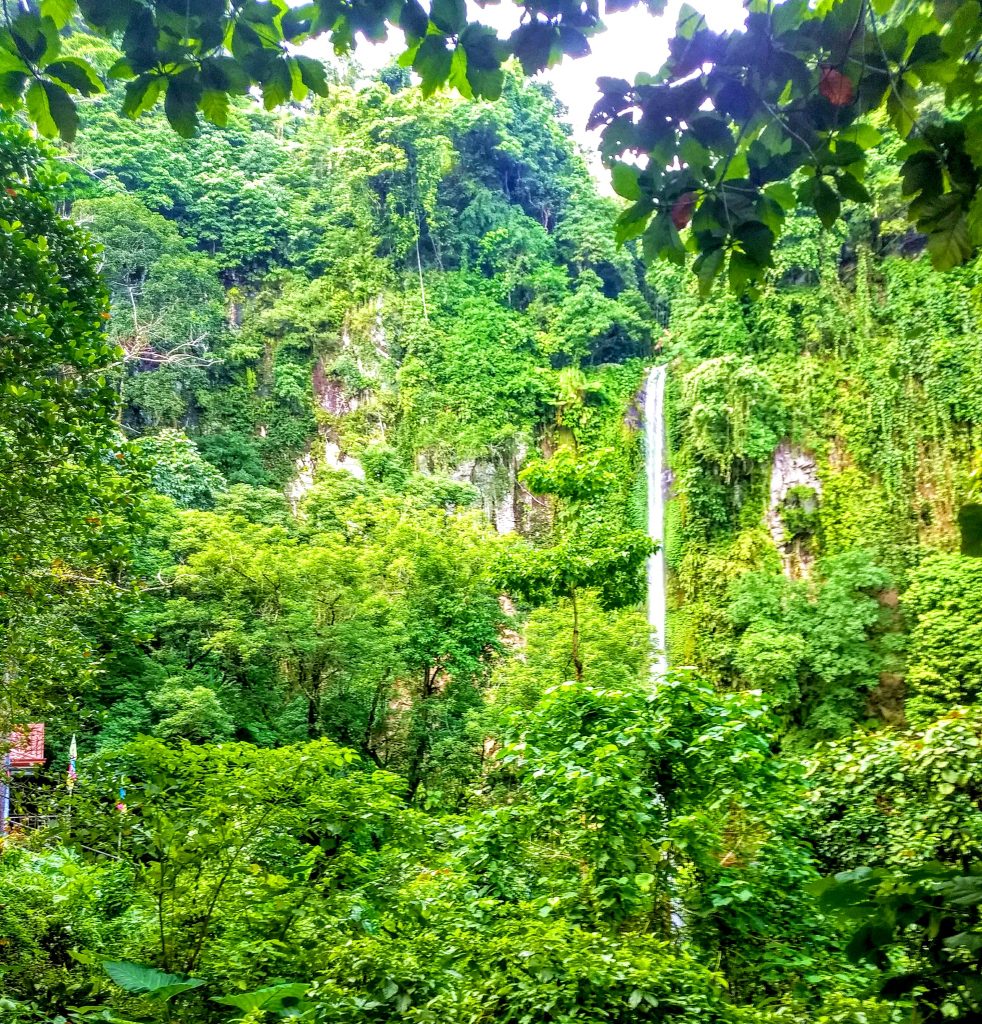
Here is a view of the falls from the viewing area with steps leading down to the basin, which you can splash about in if you like:
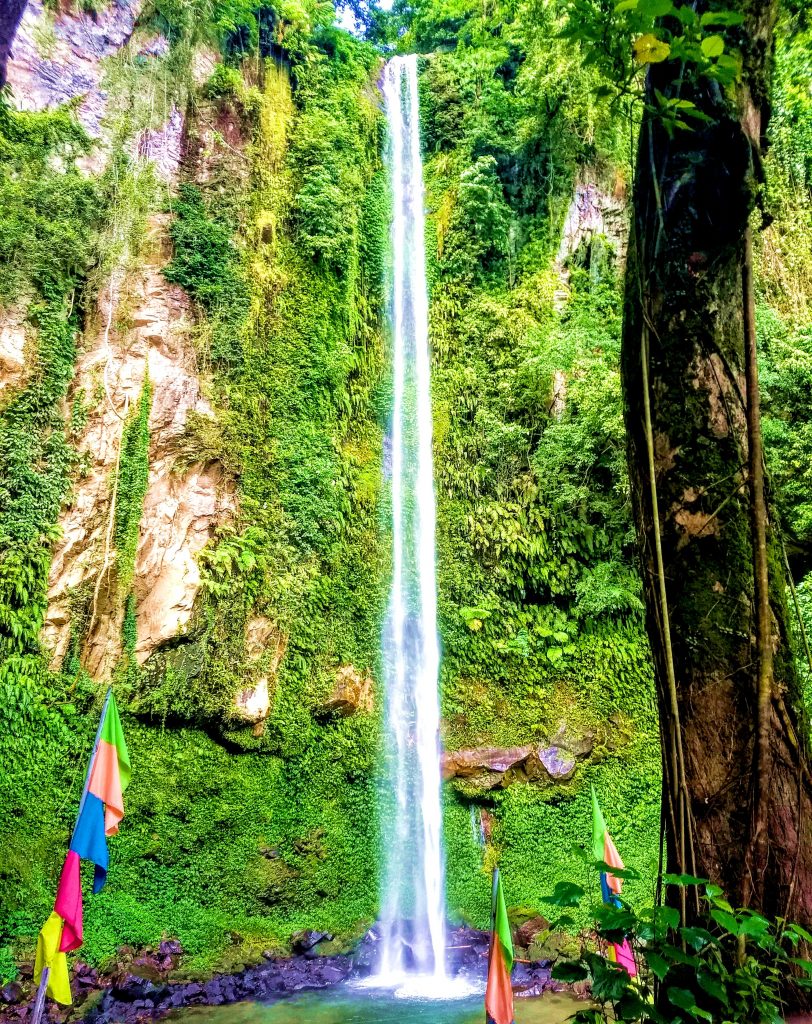
With full facilities available onsite, it would be a perfect place to spend an entire day, or even days, especially if you pull together a good picnic lunch to take with you. The vegetation is everywhere lush and I found myself wandering around looking at the plants as much as I looked at the falls, which as the pics make clear are certainly a worthy object of contemplation. It’s a delightful area that deserves lots of time and richly rewards whatever part of your day you spend there. The drive there is easy, too, no hairy switchback mountain roads to negotiate in the process.
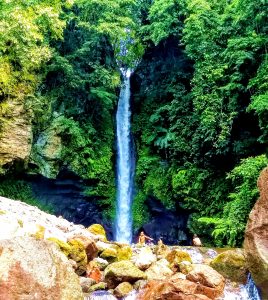
Tuasan Falls is much more natural a site than Katibawasan, with no developed grounds around it. This is the place to experience Nature pure and simple on its own terms. The waterfall is much lower, the water volume is higher and the basin it carves in its fall is much larger and deeper. It spawns a small mountain river that goes tumbling down a boulder-strewn bed from the basin. To judge from the number of kids splashing about in the basin, Tuasan is the obvious choice for those looking to combine a swim with a visit to a waterfall. If you have your own transportation, then you can go back and forth between the two falls as much as you like. You can get a tricycle to take you from Mambajao to Katibawasan, which is not far at all from the town. The road to Tuasan Falls is not difficult to find and the ascent is not difficult, but it’s a good way from Mambajao so you’ll need most of a day to see it by excursion if you don’t have your own wheels.
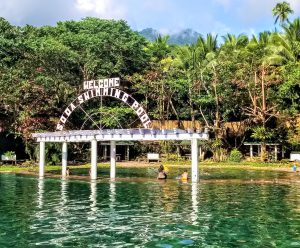
The list of sights on the island is not enormous and in the five days of my stay I took in most of them, a duty I felt incumbent on me as a first-time tourist. The Soda Pool, not very far from Tuasan Falls, is the spot for swimming pool fun ne plus ultra. The water has conveniently been laced by the underground volcanics with sodium bicarbonate (NaHCO3) which supposedly adds to the fun, although in exactly what way the fun doubles (or trebles?) remains opaque to my understanding. It’s a lovely facility and extremely popular with the local folks. Water from the source is available for oral administration, as well, so if you’re having a spot of gippy tummy from something you ate the night before, have a swig, it might help. The major fun for me was watching little Filipino kids divebombing their dads and squealing with laughter as they came up for air. Those little dickens …
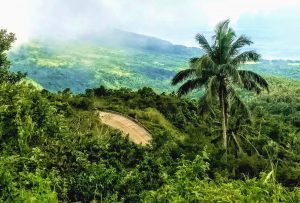
The highland areas are extremely interesting and when I return to Camiguin — in a state of better preparedness than I had on my first visit — I intend to spend much more time in that environment. As you ascend the slopes the views are stunning and the vegetation changes noticeably. Once you’re near the upper reaches you see the clouds drift through the trees and the air is noticeably cooler. The quietness is also different, as one notices in an alpine environment. What struck me most forcefully when I reached the end of the mountain road I drove up and stopped to survey the scene was how completely different the forest is at the highest elevations. Not a coconut in sight, whereas in the lowlands they are everywhere, sometimes covering the greater part of a hillside. Ditto for bananas. If I knew the tree species in the Philippines as well as I wish I did, I’d have been able to do a cursory comparison with the species I’d observed in the mountains on Panay Island, but an impression was the best I could manage. The differences were noticeable, and no pines were present. So there are two worlds on Camiguin, the lowland world and that of the highlands. The taste I had of the upper domain whetted my appetite for much more. You can see the clouds hugging the tops of the mountains on the island all the time. Once you’re up where that action takes place, it’s not at all like being enveloped in fog, as one might think. A thin and diaphanous tissue of mist trails slowly across the landscape, shifting shape continually as it passes. Quite magical, really, and a good enough show in itself to keep me occupied for long while. And as always, if you’re warned by locals about “cold” take it with a major grain of salt. Your short sleeves will not leave you with your teeth chattering, have no fear.
A few more practicalities, by way of envoy. One can never be sure if unpleasantness encountered as a tourist is due to one’s own bad luck or to some more generic phenomenon that others would be as likely to bump up against. The frequency with which I encountered dismissive or downright rude behavior from service providers, however, leads me to believe that more than just bad luck was operative. Camiguin has not been at the tourism business for a long time and the number of expats who have moved in to take advantage of the expat tourist market is still relatively small. The islanders are used to being amongst themselves without having to worry much about outsiders. The opening of the airport with frequent flights from Cebu means that the expat tourist numbers continue to grow. Filipinos from Mindanao, just a short distance to the south, have long made Camiguin a vacation spot, but they are used to doing things the local way, unlike western backpackers or resort types. The tourist infrastructure is not well developed in most of the island. To the west of Mambajao there is what amounts to a resort strip, as it were, where most of the expat tourists end up staying. That’s where you’ll find the posher restaurants, the all-inclusive resorts and such like.
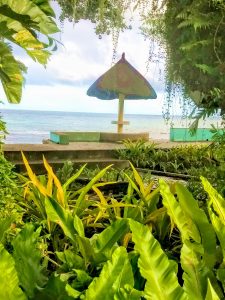
I consider myself a flexible and resourceful person and I’m quite happy to carry my own weight even as a tourist, including bussing my own table or washing my own coffee cup. So I can’t possibly be accused of being the type who demands to be fanned while being fed peeled grapes. Despite that ready spirit of accommodation, I encountered on several occasions at establishments in the resort zone in response to (quite reasonable) requests for service a response that indicated astonishment or annoyance (or both) at my importuning foreign self. And in one sari-sari (aka mom and pop) store I patronized in Mambajao I was openly mocked for my accent, which is as unoffensively American and as easy for the Filipino ear as may be. I find such behaviors baffling in a tourist area still struggling visibly with poverty, since the satisfaction of tourist requests is what brings home the bacon at the end of the day, but there it is. Being the adaptable creature I am, I quickly shifted to finding ways to meet my own needs without assistance and avoided interactions with local personnel whenever possible. That strategy made my stay much more pleasant. If you visit and find the atmosphere soured by such disagreeable experiences, you might do well to adopt a similar strategy.
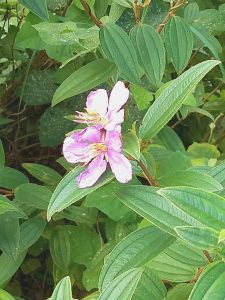
It seemed to me that the good people of Camiguin prefer to be left to their extremely relaxed island life as they lived it before the advent of these annoying creatures called tourists with their requests and their questions and their schedules. The roots of “the island life” in the typically Filipino sense of the term go deep there and are not likely to change quickly. Customer service is a dodgy concept anywhere in the Philippines, despite all the empty rhetoric about it, and on the small islands like Camiguin the reality of it is as good as absent. So just bypass things as much as you can and let “helpy selfy” be your motto. You’ll have much less wear and tear on your nerves if you do.
As for accommodation, make sure you find a place that has all the features of a standard inn or hotel. Both locals and expats will list private accommodation as though it were a Hilton or a Marriott, with 24 hour front desk, room service, etc. etc. It’s all complete piffle. So look at the listing very carefully and garner as much information as you can before you book. I suggest that you also have at least two backup options available with you when you travel, in case option number one turns out not to be exactly as represented. I had to go to Option Two before I even got a chance to see the Number One I had booked (fully two months in advance), which was listed as a seaside villa and turned out to be a house owned by an expat living overseas who left the property in the hands of a local “caretaker” who had brought in family members and had no intention of renting the house out to tourists, so he simply blew me off and stopped answering the phone. I wasn’t out any money, fortunately, but I did need to go very quickly to Plan B and was glad I had one sorted out and ready to go. And if you’re the Airbnb type, don’t even THINK of going there, Bridget. This ain’t Kansas and all bets are off, babes. Just trying to play it safe puts you far enough out on a limb — no need to aggravate the situation, is there, so just stifle yourself. Save your Airbnb for home, where there’s such a thing as Consumer Rights and people actually answer the Customer Service number. Out here you ain’t nothin’ but a hound dog.
As I said, being better prepared now by my experience from the first trip, I look forward to returning to Camiguin to explore in greater depth the many spots of loveliness it has to offer. The mountains and the sea cheek by jowl — now that’s the South Seas for you. I can’t wait to go back for more. And the sunsets! Aaaahhhh …
